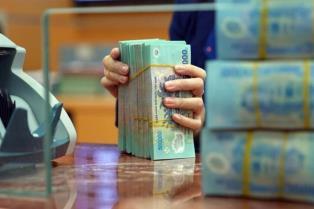The banking system's credit growth reached about 10 per cent after seven months, significantly higher than the 6 per cent recorded in the same period in 2024, according to the State Bank of Vietnam (SBV).

HÀ NỘI — Despite a marked improvement in the economy’s capital absorption capacity, large capital flows remain concentrated in real estate and the stock market, raising risks of imbalance and bad debts.
The banking system's credit growth reached about 10 per cent after seven months, significantly higher than the 6 per cent recorded in the same period in 2024, according to the State Bank of Vietnam (SBV).
The half-year financial report shows that the total outstanding loans of 27 listed banks and the Vietnam Bank for Agriculture and Rural Development (Agribank) stood at some VNĐ14.94 quadrillion (US$574.6 billion) by the end of the second quarter, up more than 10 per cent compared to the end of 2024.
The Big 4 – BIDV, VietinBank, Vietcombank, and Agribank – dominated with a combined market share of over 50 per cent, equivalent to about VNĐ7.5 quadrillion in outstanding loans. VietinBank saw a credit growth rate of around 10 per cent, Agribank 7.6 per cent, Vietcombank 7 per cent, and BIDV 6 per cent compared to the year's beginning.
Several banks have posted credit growth far exceeding the industry average. Representatives from NCB said that after six months, the bank’s loan portfolio hit 90.4 per cent of its annual target thanks to the focus on customers with high credit scores and promotion of digital technology application for quick and convenient disbursement.
Phạm Thị Hoàng Anh, Deputy Director of the Banking Academy’s Board of Directors, commented that such strong credit growth reflects clear opportunities for production and business investment.
This stems from the Party and Government's decisive changes regarding mechanisms, policies, and institutions, thereby boosting confidence among both domestical and international investors. However, credit expansion must be accompanied by quality assurance and directed towards priority sectors as in line with socio-economic development goals, she noted.
Nguyễn Thường Lạng, senior lecturer at the National Economics University, held that to achieve the Government’s economic growth target for this year, credit in the remaining five months must increase by about 1.8 to 2.3 times compared to the first seven months.
Importantly, capital efficiency must improve, and priority be given to green exports, renewable energy, high technology, and effective projects. Lower lending rates will stimulate both aggregate demand and supply, supporting sustainable growth.
Amid the overall credit growth, a large flow of capital is strongly pouring into real estate and the stock market. As of June 30, outstanding real estate credit stood at around VNĐ3.18 quadrillion, 2.4 times higher than at the end of 2024 and accounting for 18.5 per cent of the system's total outstanding loans.
At Techcombank, real estate business lending (including credit and bonds) accounts for 59 per cent of total outstanding loans. Consolidated real estate business credit increased 21.5 per cent, nearly double the bank’s overall growth rate of 11.6 per cent.
Several other banks also reported sharp increases in lending for this sector such as MB 34 per cent, SHB 28.4 per cent, and HDBank 22 per cent compared to the start of 2025 .
Meanwhile, margin lending for stock purchases has hit a record high. Outstanding margin loans at Vietnamese securities companies currently total about VNĐ303 trillion, the highest ever.
Experts warned that excessive capital concentration in high-risk sectors like real estate and securities, risks of imbalances and non-performing loans could increase.
Phạm Thị Hoàng Anh has urged commercial banks to strike a balance between expanding loan portfolios and maintaining credit quality. She emphasised that medium- and long-term capital should be more strongly developed through the stock and bond markets to ease pressure on the banking system and improve the sustainability of credit.
At the Government's recent monthly meeting with provinces and cities, SBV Governor Nguyễn Thị Hồng stressed that real estate credit growth outpacing the average is consistent with the policy of supporting this market. Once project bottlenecks are removed, capital demand is inevitable. Regarding securities, she noted that credit for stock investment accounts for only 1.5 per cent of total outstanding loans and does not pose systemic risk.
The Governor reaffirmed that SBV is closely monitoring safety indicators, with the ratio of short-term capital used for medium- and long-term loans still below the 30 per cent threshold. Credit institutions must balance funds by maturity to ensure system safety.
SBV’s orientation is to tightly control credit flowing into risky sectors, prioritise capital for production, exports, manufacturing, green energy, and economic restructuring, while continuing to require credit institutions to keep deposit rates stable and further cut lending rates. — VNS





